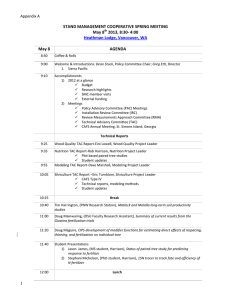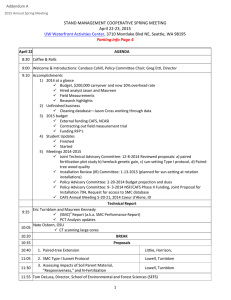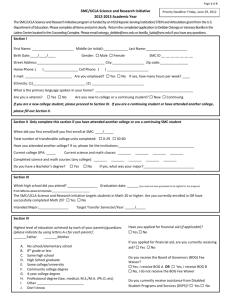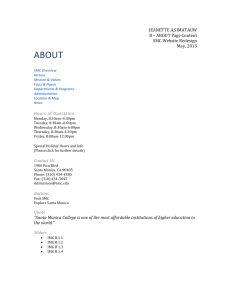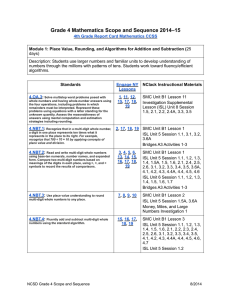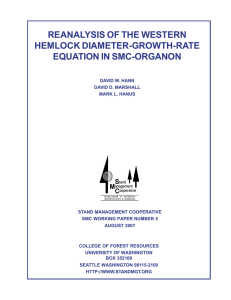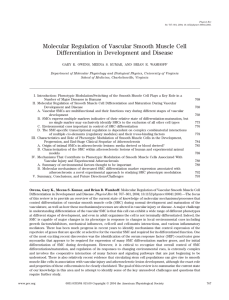SMC Fact Sheet Mission: What is the Stand Management Cooperative?
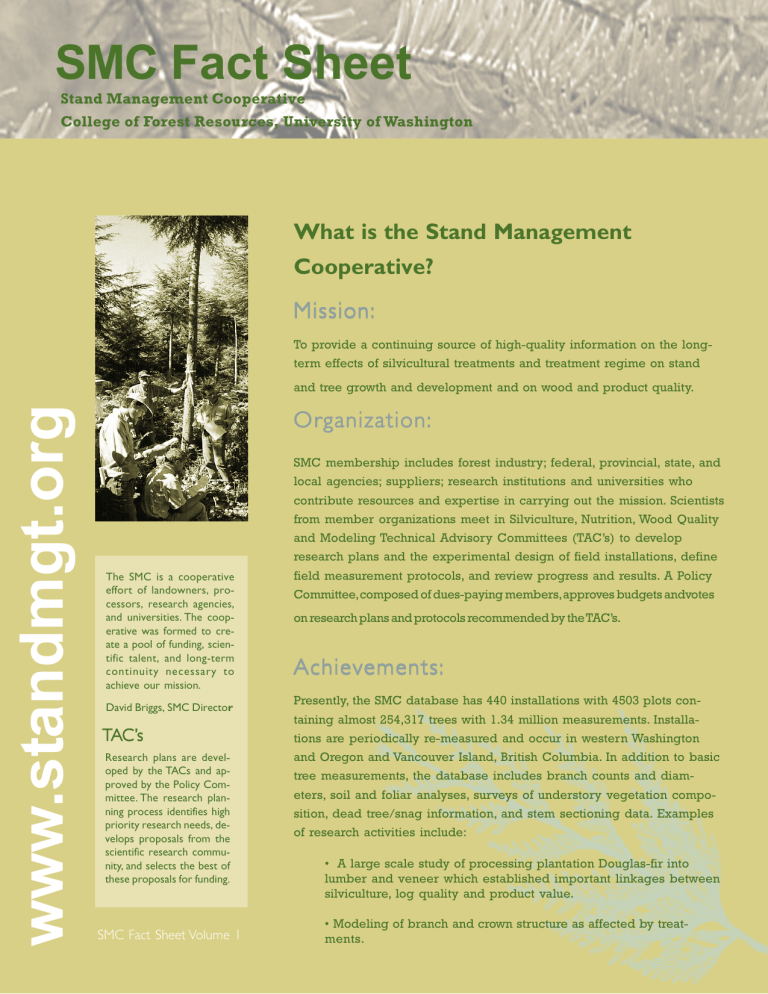
SMC Fact Sheet
Stand Management Cooperative
College of Forest Resources, University of Washington
What is the Stand Management
Cooperative?
To provide a continuing source of high-quality information on the longterm effects of silvicultural treatments and treatment regime on stand and tree growth and development and on wood and product quality.
The SMC is a cooperative effort of landowners, processors, research agencies, and universities. The cooperative was formed to create a pool of funding, scientific talent, and long-term continuity necessary to achieve our mission.
David Briggs, SMC Directo r
T A C’
Research plans are developed by the TACs and approved by the Policy Committee. The research planning process identifies high priority research needs, develops proposals from the scientific research community, and selects the best of these proposals for funding.
SMC Fact Sheet Volume 1
SMC membership includes forest industry; federal, provincial, state, and local agencies; suppliers; research institutions and universities who contribute resources and expertise in carrying out the mission. Scientists from member organizations meet in Silviculture, Nutrition, Wood Quality and Modeling Technical Advisory Committees (TAC’s) to develop research plans and the experimental design of field installations, define field measurement protocols, and review progress and results. A Policy
Committee, composed of dues-paying members, approves budgets andvotes on research plans and protocols recommended by the TAC’s.
Presently, the SMC database has 440 installations with 4503 plots containing almost 254,317 trees with 1.34 million measurements. Installations are periodically re-measured and occur in western Washington and Oregon and Vancouver Island, British Columbia. In addition to basic tree measurements, the database includes branch counts and diameters, soil and foliar analyses, surveys of understory vegetation composition, dead tree/snag information, and stem sectioning data. Examples of research activities include:
• A large scale study of processing plantation Douglas-fir into lumber and veneer which established important linkages between silviculture, log quality and product value.
• Modeling of branch and crown structure as affected by treatments.
Land Managing
Organizations
B.C. Ministry of Forests
Boise Cascade Corporation
Bureau of Land Management
Campbell Group
Cascade Timber Consultants
Green Diamond Resource Company
Forest Systems Inc.
FORSight Resources, LLC
Hampton Tree Farms
Hancock Timber Resource Group
Lone Rock Timber Company
Longview Fibre Company
Mason, Bruce & Girard
Metropolitan King County
Olympic Resource Management
Oregon State Department of Forestry
Pacific Denkmann
Plum Creek Timber Company
Port Blakely Tree Farms
Quinault Department of Natural
Resources
Rayonier Timberlands
Simplot SoilBuilders
TimberWest-Coast Timberlands
Washington State Department of
Natural Resources
West Fork Timber Company
Weyerhaeuser Company
Suppliers
Agrium
Dyno-Nobel
Simplot SoilBuilders
Institutions
B.C. Ministry of Forests, Research
Branch
Canadian Forest Service
Forintek Canada
Oregon State University
USFS Pacific Northwest Research
Station
University of British Columbia
University of California, Berkeley
University of Washington
Washington State University
West Coast Lumber Inspection Bureau
• Analysis of growth, stem form, epicormic branching, and occlusion of branches after pruning.
• A new regional growth and yield model; SMC-ORGANON.
• An analysis of tree and understory vegetation and diversity in young stands receiving different treatments.
• Evaluation of carbon sequestration in managed stands; the
SMC is the Western Regional Site of the US DOE National
Carbon Sequestration Center.
• The carry-over effect of fertilization into the growth and vegetation development of the next stand.
• The SMC maintaines a website and produces publications, seminars and workshops to communicate the latest results to members.
The long-term future of the Pacific Northwest forest industry depends on the productivity of the region’s forests and the choice of sound, cost-effective and environmentally responsible management regimes. Reliable estimates and projections are needed of how individual silvicultural treatments and treatment combinations affect stand growth and yield, product quality and value, and environmental concerns such as diversity habitat and carbon sequestration. The overall goal is to provide information and models that assist managers in making intelligent choices among management regimes to achieve desired wood yield and quality, investment, and environmental objectives.
The cost of establishing and maintaining long-term field research on the scale required to build an adequate regional database to provide managers with the necessary decision support is beyond the scope and capabilities of any single organization. This can only be achieved through a cooperative effort among landowners, manufacturers, research agencies and universities.
University of Washington, Box 352100, Seattle, Washington 98195-2100
Phone: 206-543-5355 Fax 206-685-3091 email: dbriggs@u.washington.edu
